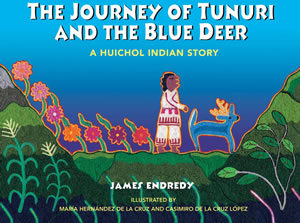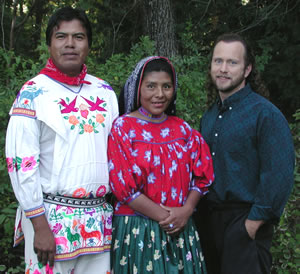

The Author and Illustrators
|
Program Outline
|
Huichol Indian Culture,
Art, and Folklore -
A multicultural and cross-curriculum learning program for students in
Grades 3-5
Dear Educators,
I am pleased to introduce you to a school visitation program that may
be of great value to your students:
| Purpose: Make the learning of multicultural concepts in Social Studies and Visual Arts both informative and fun, while at the same time enhancing the school's curriculum through programs presented by a well known author and speaker. |
Objectives: The students will increase their comprehension of cultural diversity and global connections by learning about a Native American culture that still lives a traditional lifestyle, and how that culture relates to human-environment interactions. |
Schedule:
· 15 minutes set-up.
· 60 minutes presentation grade 3, 75 minutes grades 4 and 5 (there
is a lot of flexibility here depending on the needs/wants of the school)
· 15 minutes between presentations in the same room, 30 minutes
when changing rooms.
· 15 minutes or more for signing of books depending on class size
(when applicable)
· 60 minutes for lunch
· Teacher or aide must be present.
Fees for 2017-2018 school year:
· $600/day for 3-4 presentations, plus travel expenses if outside
the south western Vermont area. Schools outside the area are encouraged
to team up and book multiple days to keep expenses down.
· $400/half day for 2 presentations.
· $200/after-school/evening/weekend for 1 presentation.
· Discounts available on books for the program depending on quantity.
Correlation between the program "Huichol Indian Culture, Art,
and Folklore" by James Endredy and the Curriculum Standards established
by the National Council for Social Studies
- Social studies programs should include experiences that provide for the study of culture and cultural diversity.
· The program encourages the understanding that in a multicultural society, students need to be sensitive to multiple perspectives that derive from different cultural vantage points.
· By clearly identifying various aspects of a culture different from their own (in this case the Huichol Indian culture) the program helps children to understand themselves as both individuals and members of various groups.
· The program demonstrates how human cultures exhibit both similarities and differences.
- Social studies programs should include experiences that provide for the study of people, places, and environments.
· The program's multi-cultural content of people, places, and human-environment interactions assists learners as they create their spatial views and geographic perspectives of the world.
· The program describes ways in which language, stories, folktales, and artistic creations serve as expressions of culture and influence the behavior of people living in a particular culture.
· The program compares ways in which people from different cultures think about and deal with their physical environment and social conditions.
- Social studies programs should include experiences that provide for the study of global connections and interdependence.
· The program helps geographic concepts become central to learners' comprehension of global connections as they expand their knowledge of diverse cultures, both historical and contemporary.
· The program helps learners draw upon immediate personal experiences as a basis for exploring geographic concepts and skills while providing answers for children beginning to express interest in things distant and unfamiliar, and to have concern for the use and abuse of the physical environment.
· Through exposure to various media and first-hand experiences, young learners become aware of and are affected by events on a global scale. Within this context, the program encourages students in early grades to examine and explore global connections.
The program can also be used to effectively develop interrelations between Social Studies and the Visual Arts by:
- Understanding the visual arts in relation to history and cultures.
· The program demonstrates how the visual arts have both a history and specific relationships to various cultures.
· The program shows students that they can identify specific works of art as belonging to particular cultures, times, and places.
· The program demonstrates how history, culture, and the visual arts can influence each other in making and studying works of art.
To book this program or for more information:
contact James.